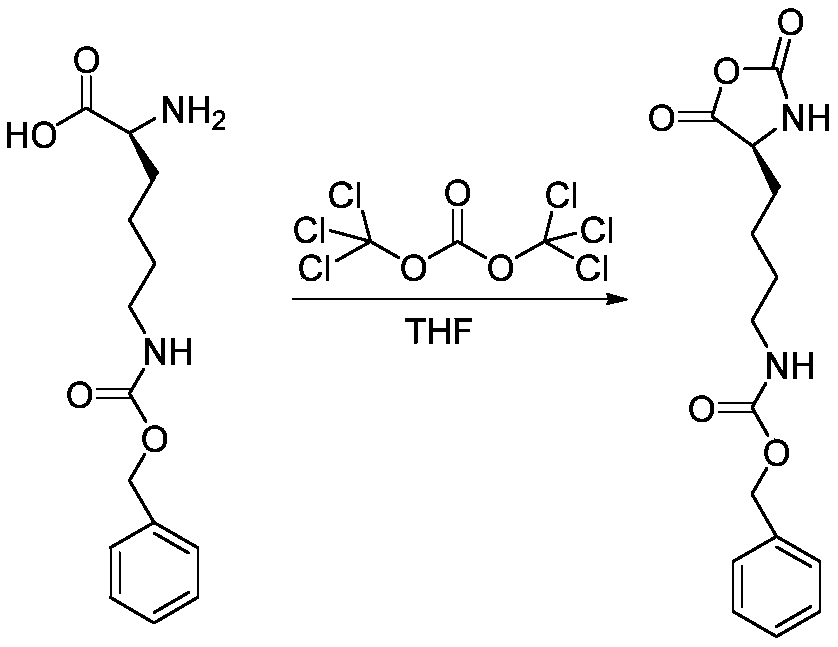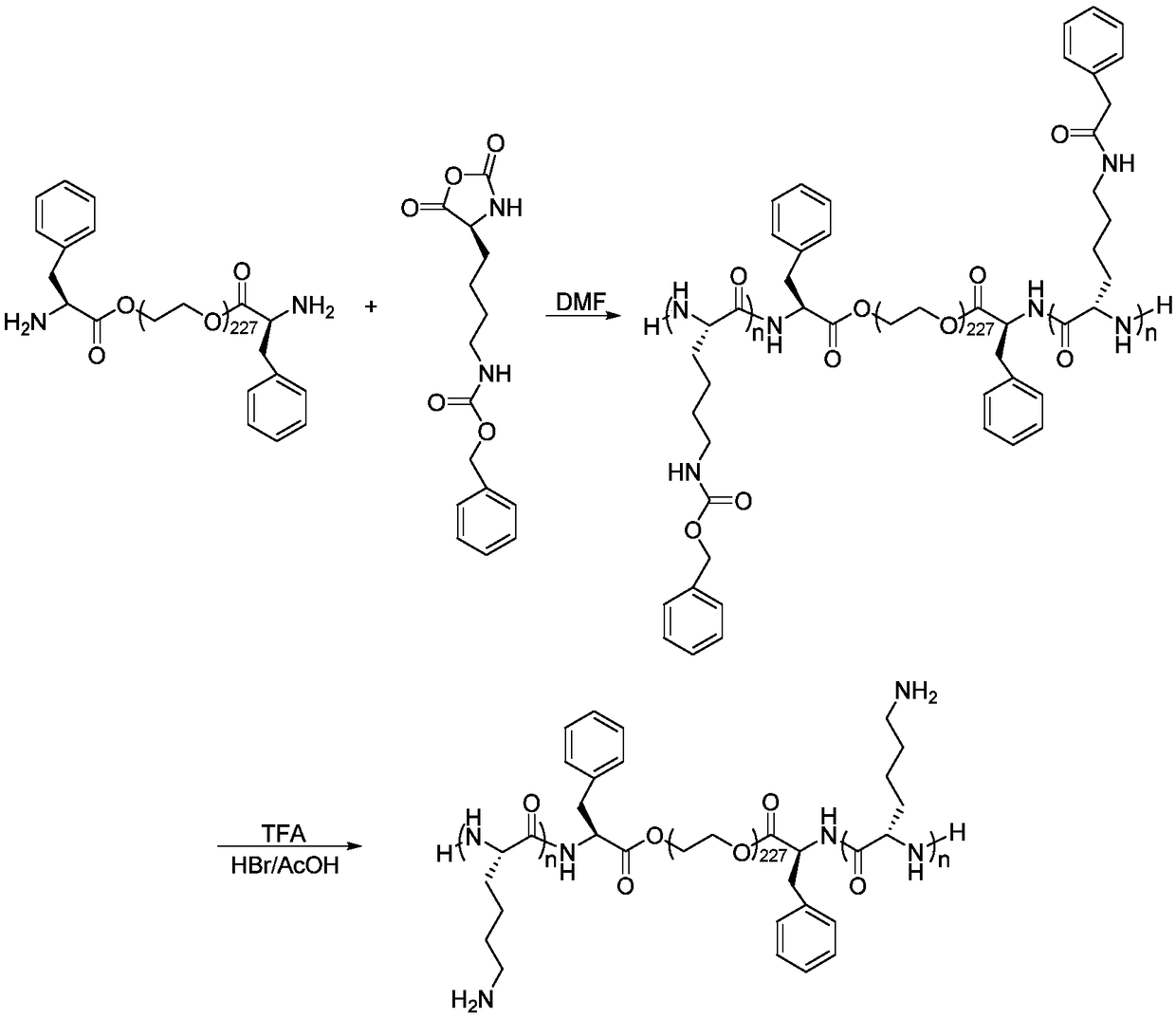Preparation method and application of a hybrid hydrogel material
A hydrogel and hybrid technology, which is applied in the field of preparation of hybrid hydrogel materials, can solve the problems of irreversibility, complex operation conditions, and undisclosed electrostatic interaction to construct hybrid supramolecular hydrogel materials.
- Summary
- Abstract
- Description
- Claims
- Application Information
AI Technical Summary
Problems solved by technology
Method used
Image
Examples
Embodiment 1
[0079] 1. Raw materials
[0080] 1.1 Synthesis of macromolecular initiator NH 2 -Phe-PEG 227 -Phe-NH 2 raw material
[0081]
[0082] 1.2 Raw materials for the synthesis of Lys(Z)-NCA
[0083] H-Lys(Z)-OH 1g, 3.57mmol
[0084] Triphosgene 0.42g, 1.43mmol
[0085] 1.3 Raw materials for the synthesis of polylysine-polyethylene glycol-polylysine
[0086] NH 2 -Phe-PEG 227 -Phe-NH 2 1g, 0.1mmol
[0087] Lys(Z)-NCA 0.31g, 1mmol
[0088] 1.4 Raw materials for the synthesis of hybrid hydrogels
[0089] The charge concentrations of the positively charged amino groups of polylysine and the negatively charged phosphate groups in the DNA structure are respectively controlled at 20mM, and the charge molar ratio of the triblock copolymer to protist DNA is 1:16.
[0090] 2. Preparation method
[0091] 2.1 Synthesis of phenylalanine-terminated polyethylene glycol (NH 2 -Phe-PEG 227 -Phe-NH 2 )
[0092] Phenylalanine-terminated polyethylene glycol (NH 2 -Phe-PEG 227 -Ph...
Embodiment 2
[0113] 1. Raw materials
[0114] 1.1 Synthesis of macromolecular initiator NH 2 -Phe-PEG 227 -Phe-NH 2 raw material
[0115]
[0116] 1.2 Raw materials for the synthesis of Lys(Z)-NCA
[0117] H-Lys(Z)-OH 0.8g, 2.85mmol
[0118] Triphosgene 0.339g, 1.14mmol
[0119] 1.3 Raw materials for the synthesis of polylysine-polyethylene glycol-polylysine
[0120] NH 2 -Phe-PEG 227 -Phe-NH 2 0.8g, 0.08mmol
[0121] Lys(Z)-NCA 0.49g, 1.6mmol
[0122] 1.4 Raw materials for the synthesis of hybrid hydrogels
[0123] The charge concentrations of the positively charged amino groups of polylysine and the negatively charged phosphate groups in the DNA structure are respectively controlled at 20mM, and the charge molar ratio of the triblock copolymer to protist DNA is 1:10.
[0124] 2. Preparation method
[0125] 2.1 Synthesis of phenylalanine-terminated polyethylene glycol (NH 2 -Phe-PEG 227 -Phe-NH 2 ) method with embodiment 1.
[0126] 2.2 Synthesis of Lys(Z)-NCA
[012...
Embodiment 3
[0138] 1. Raw materials
[0139] 1.1 Synthesis of macromolecular initiator NH 2 -Phe-PEG 227 -Phe-NH 2 raw material
[0140]
[0141] 1.2 Raw materials for the synthesis of Lys(Z)-NCA
[0142] H-Lys(Z)-OH 1.5g, 5.35mmol
[0143] Triphosgene 0.635g, 2.14mmol
[0144] 1.3 Raw materials for the synthesis of polylysine-polyethylene glycol-polylysine
[0145] NH 2 -Phe-PEG 227 -Phe-NH 2 1.2g, 0.12mmol
[0146] Lys(Z)-NCA 0.294g, 0.96mmol
[0147] 1.4 Raw materials for the synthesis of hybrid hydrogels
[0148] The charge concentrations of the positively charged amino groups of polylysine and the negatively charged phosphate groups in the DNA structure are respectively controlled at 20mM, and the charge molar ratio of the triblock copolymer to protist DNA is 1:20.
[0149] 2. Preparation method
[0150] 2.1 Synthesis of phenylalanine-terminated polyethylene glycol (NH 2 -Phe-PEG 227 -Phe-NH 2 ) method with embodiment 1.
[0151] 2.2 Synthesis of Lys(Z)-NCA
[0...
PUM
 Login to View More
Login to View More Abstract
Description
Claims
Application Information
 Login to View More
Login to View More - R&D
- Intellectual Property
- Life Sciences
- Materials
- Tech Scout
- Unparalleled Data Quality
- Higher Quality Content
- 60% Fewer Hallucinations
Browse by: Latest US Patents, China's latest patents, Technical Efficacy Thesaurus, Application Domain, Technology Topic, Popular Technical Reports.
© 2025 PatSnap. All rights reserved.Legal|Privacy policy|Modern Slavery Act Transparency Statement|Sitemap|About US| Contact US: help@patsnap.com



